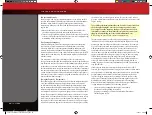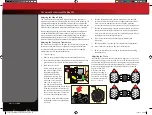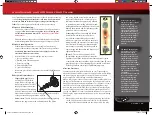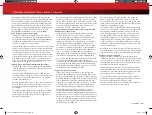
20 • T-MAXX
See page 27 for more
information on how air
density affects engine tuning.
The Carburetor
Understanding the Carburetor adjustments
The carburetor performs several functions. It controls the engine’s
speed by restricting the intake of air and fuel into the engine. It
atomizes the fuel (suspends the fuel droplets in the air) and also
controls the air/fuel ratio of the mixture entering the engine (how
much air for a given amount of fuel).
To help provide a better understanding of engine tuning and why
it’s necessary, the following is a brief explanation of the air/fuel
combustion process that takes place inside the engine.
In order to create the cylinder pressure that results in power, the
engine burns the air/fuel mixture. Both air and fuel, in correct
amounts, are needed for proper combustion. It is the carburetor’s
job to mix the air and fuel together (atomize the fuel), in the correct
proportion for the best possible combustion. This is the ideal air/fuel
ratio. The ideal air/fuel ratio required for the engine remains roughly
constant. Due to variations in atmospheric conditions (temperature,
humidity, altitude, etc.), fuel flow adjustment valves (called fuel
mixture needles) are required to meter the fuel and maintain the ideal
air/fuel ratio in these ever-changing conditions. For example, colder
air is more dense (more air molecules) for a given volume of air and
therefore requires more fuel (more fuel molecules) to maintain the
correct air/fuel ratio. Warmer air is less dense (fewer air molecules)
and therefore needs less fuel to maintain the correct air/fuel ratio. The
tuning needles are there to adjust how much fuel is made available for
the carburetor to mix with the available air (atomization).
The Fuel Mixture Needles
The amount of fuel metered and atomized by the carburetor is
controlled by the two mixture needles, the high-speed needle and
the low-speed needle. The low-speed needle is used to meter the fuel
used by the engine at idle and low RPM (part-throttle) engine speed.
The high-speed needle is used to meter the fuel when the throttle is
open from part throttle to wide-open throttle (WOT). Two needles on
the TRX 2.5 Racing Engine provide precise control of the air/fuel ratio
across the engine’s entire RPM range.
The maximum possible fuel flow is always controlled by the high-
speed needle. It works like the main water valve on a garden hose.
Turn it clockwise to close the valve, counterclockwise to open it.
When the throttle is at idle or partially open, the low-speed needle
meters the fuel flow at the outlet (needle seat) where the fuel enters
the carburetor venturi. This second valve acts like the spray nozzle
at the end of the garden hose in our example. When you accelerate
from idle, the throttle opens and the low-speed needle is pulled away
from the needle seat. This allows more fuel to flow with the increased
air flow. As the throttle is increased, the low-speed needle is pulled
completely away from the needle seat, leaving it fully open. At that
Air
Fuel
Cold Air (More Dense)
(Warm Air) Less Dense
Start
1/8 Turn
45°
Full Turn
360°
1/2 Turn
180°
1/4 Turn
90°
3/4 Turn
270°
A “turn” refers to
tightening (“turning in”) or
loosening (“turning out”)
mixture needles. A “full
turn” refers to turning the
needle 360°, so a “1/2 turn”
would be 180°, a “1/4 turn”
would be 90°, and so on.
THE TRX 2.5 RACING ENGINE
49104-1-KC2230-R00-T-Maxx-Operating.indd 20
10/30/14 5:10 PM
















































